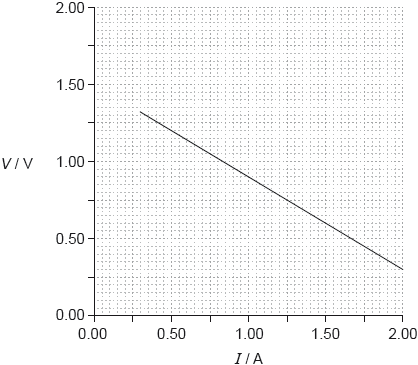| Date | May 2019 | Marks available | 1 | Reference code | 19M.2.SL.TZ1.1 |
| Level | Standard level | Paper | Paper 2 | Time zone | 1 |
| Command term | Calculate | Question number | 1 | Adapted from | N/A |
Question
A girl rides a bicycle that is powered by an electric motor. A battery transfers energy to the electric motor. The emf of the battery is 16 V and it can deliver a charge of 43 kC when discharging completely from a full charge.
The maximum speed of the girl on a horizontal road is 7.0 m s–1 with energy from the battery alone. The maximum distance that the girl can travel under these conditions is 20 km.
The bicycle and the girl have a total mass of 66 kg. The girl rides up a slope that is at an angle of 3.0° to the horizontal.
The bicycle has a meter that displays the current and the terminal potential difference (pd) for the battery when the motor is running. The diagram shows the meter readings at one instant. The emf of the cell is 16 V.
The battery is made from an arrangement of 10 identical cells as shown.
Show that the time taken for the battery to discharge is about 3 × 103 s.
Deduce that the average power output of the battery is about 240 W.
Friction and air resistance act on the bicycle and the girl when they move. Assume that all the energy is transferred from the battery to the electric motor. Determine the total average resistive force that acts on the bicycle and the girl.
Calculate the component of weight for the bicycle and girl acting down the slope.
The battery continues to give an output power of 240 W. Assume that the resistive forces are the same as in (a)(iii).
Calculate the maximum speed of the bicycle and the girl up the slope.
On another journey up the slope, the girl carries an additional mass. Explain whether carrying this mass will change the maximum distance that the bicycle can travel along the slope.
Determine the internal resistance of the battery.
Calculate the emf of one cell.
Calculate the internal resistance of one cell.
Markscheme
time taken «= 2860 s» = 2900«s» ✔
Must see at least two s.f.
use of E = qV OR energy = 4.3 × 103 × 16 «= 6.88 × 105 J» ✔
power = 241 «W» ✔
Accept 229 W − 241 W depending on the exact value of t used from ai.
Must see at least three s.f.
use of power = force × speed OR force × distance = power × time ✔
«34N» ✔
Award [2] for a bald correct answer.
Accept 34 N – 36 N.
66 g sin(3°) = 34 «N» ✔
total force 34 + 34 = 68 «N» ✔
3.5 «ms-1»✔
If you suspect that the incorrect reference in this question caused confusion for a particular candidate, please refer the response to the PE.
Look for ECF from aiii and bi.
Accept 3.4 − 3.5 «ms-1».
Award [0] for solutions involving use of KE.
Award [0] for v = 7 ms-1.
Award [2] for a bald correct answer.
«maximum» distance will decrease OWTTE ✔
because opposing/resistive force has increased
OR
because more energy is transferred to GPE
OR
because velocity has decreased
OR
increased mass means more work required «to move up the hill» ✔
V dropped across battery OR Rcircuit = 1.85 Ω ✔
so internal resistance = = 0.62«Ω» ✔
For MP1 allow use of internal resistance equations that leads to 16V − 12V (=4V).
Award [2] for a bald correct answer.
= 3.2 «V» ✔
ALTERNATIVE 1:
2.5r = 0.62 ✔
r = 0.25 «Ω» ✔
ALTERNATIVE 2:
= 0.124 «Ω» ✔
r = 2(0.124)= 0.248 «Ω» ✔
Allow ECF from (d) and/or e(i).
Examiners report
This question was generally well answered. Candidates should be reminded on questions where a given value is being calculated that they should include an unrounded answer. This whole question set was a blend of electricity and mechanics concepts, and it was clear that some candidates struggled with applying the correct concepts in the various sub-questions.
Many candidates struggled with this question. They either simply calculated the weight, used the cosine rather than the sine function, or failed to multiply by the acceleration due to gravity. Candidates need to be able to apply free-body diagram skills in a variety of “real world” situations.
This question was well answered in general, with the vast majority of candidates specifying that the maximum distance would decrease. This is an “explain” command term, so the examiners were looking for a detailed reason why the distance would decrease for the second marking point. Unfortunately, some candidates simply wrote that because the mass increased so did the weight without making it clear why this would change the maximum distance.


